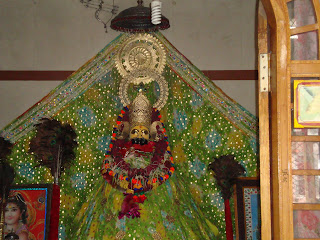
Saturday, November 12, 2011
Saturday, October 29, 2011
SALASAR BALAJI













It is believed that there was a very famous devotee of hanumanji named mohandas.He was so much dedicated to hanumanji that hanumanji usually came to meet him at his living place. Seeing him so indulge, Mohandasji's sister kandibai decided for his marriage.Other side,mohandas was not willing to get married.So he told a lie to his sister about the girl's death with whom she decided him to marry,that girl died on that day only.After this mohandas ji remained single for life. The temple was constructed/looked after under the surveillance of mohandas ji later.
The history of this temple dates back to 1811 in a village called Asota, where a farmer while ploughing his field, got stuck by some rock under the earth. After clearing the farmer found an idol of Lord Hanuman. The Thakur of that village shifted the idol to Salasar for proper religious ceremony. Thakur brought two bulls, placed hanumanji's idol on its cart and left them in the open courts by believing where ever the bulls would stop, the temple would be built up at that place only.The place where bulls stopped a temple was built up and that place was named as salasar.Many of the villagers and the shopkeepers shifted to that place and started living there.A new village came in the existence this how. Initially the idol was housed in a hut, the place later developed into a concrete temple, and today it is a large temple complex.It is said that drinking water of the wells of the salasar is blessed by the lord Hanumanji.
BAIDYANATH TEMPLE
Baidyanath or Shiva is the most important of all the temples in the courtyard. The temple faces the east and is a plain stone structure with a pyramidal tower, 72 feet tall.
The top contains three ascending shaped gold vessels that are compactly set, and were donated by the Maharaja of Giddhaur. Besides these pitcher shaped vessels, there is a Punchsula (Five knives in Tridenta shape), which is rare. In the inner top there is an eight pettaled lotus jewel called Chandrakanta Mani.
The lingam installed inside, is of a cylindrical forming about 5 inches in diameter and projects about 4 inches from the centre of a large slab of basalt. It is not possible to ascertain how much of the lingam is buried. The top is broken and has uneven surface.
There are different porches in the temple. One porch leads to the cell where the lingam is fixed. The second porch is in front with a row of pillars spanned by blocks of basalt and on the right side there is a sandstone image of nandi.
There are bells fixed in the ceiling and pilgrims are supposed to pull the bell ropes to announce their approach to the divinity.
To the east of the northern verandah of the temple there is a large masonry vat into which flows the water and milk offered to the lingam. The liquid in it is essentially a mix of milk, sandal paste and washing of flowers, which impart to it a fragrant smell and is treated as highly sacred

















RANI SATI DADI JI
BASUKINATH JYOTILINGA








